. . . As the extreme possibility of Dasein, death is capable of the greatest lighting-up of being and its truth.1
Martin Heidegger
It would appear, perhaps, . . . that all works [of art] could be defined through their rapport with the categories of Death, and that before this omnipresence of Death, the customary definitions of Classicism, the Baroque, Romanticism, archaism, realism, the picturesque, etc., etc. could be revised.
If these statements are no longer original, at least they permit us to affirm again that precisely all great works find their best analyses under the double point of view of a landscape of Death and of a symbol of artistic creation at the core of the adventure and thus, in the double implication that every work is essentially haunted [by death] and that the analytical route indicated in this Preface is perhaps the best.2 (Italics by Kimmel)
Michel Guiomar
The quotations from Heidegger and from Guiomar's most imposing construction of an aesthetics of death provide the motivation and conceptual framework for the limited study that follows. The implications of Heidegger's statement are that since death is the matrix, omnipresent boundary, and ultimate possibility and goal of Dasein (the human mode of being-in-the-world), and since life is always and at all times a being-toward-death, only he who lives continually and consciously in the understanding of this truth grasps the innermost meaning of the beings he encounters and the truth of his own existence in its "authenticity." Only in the darkness and light of death are beings truly disclosed. ". . . The understanding of death is the key to, and therefore the origin and ground of, man's total understanding of himself, the world, and being; this is true not only of individual men, but also of all the epochs of human history." (Demske, p. 171) The implications of the quotations from Guiomar are: (a) that the creative act arises as a response to a conscious or unconscious awareness of death as the original, ultimate, and ever-present adversary; (b) that creative activity and the art work are human modes of transcendence through which both the self and its world are wrought and sustained; (c) that the work is a dynamic field in which the dialectics of life and death (being and non-being) are perpetually at play.; and finally (d) that the most illuminating analysis is that which discloses the ubiquitous presence of this adversary in the work of art.
In what follows, the musical work is considered to be only secondarily a vehicle of representative, expressive or "symbolic" communication. It is first of all a being among beings in the world and, like all beings, directly through its structure, style, mode of comportment and temporal career discloses in varying degrees of scope and depth, dimensions of being—what it means to be, what is entailed in being, and the conditions, possibilities and limitations of being.3 Furthermore, adhering to the phenomenology of Mikel Dufrenne, I am defining the musical being not as the work which exists in a score for analytical explanation, but as a phenomenon that appears to consciousness only in the fullness of its sensuous, dynamic, and temporal presence—presencing or enacting itself in performance.4
Issuing from the lines of query suggested by Heidegger and Guiomar—that only in the light of their rapprochement with death is the truth of being and of beings fully and authentically disclosed—the immediate question to which the following study is a response is: In what manner does death make its appearance in the experience of music? The approaches to man's confrontation with death have been many: through mythological personifications, literary and dramatic representations, ritual and ceremonial celebrations, philosophical analyses and theological interpretations, and psychological explorations of the multiple stances and attitudes assumed toward it. While all of these may find their way into musical works through structural analogy, symbolic representation, imitation, conventional emblem, or by direct expression, the most fundamental critical approach must be structural, for music is first of all tonal structuring—the ordering of dynamics set in motion by tones, sounds, and their relationships into coherent and significant (communicative) forms. Whatever the communicable substance of music may be, it arises from the structure of tonal relations. If death makes its appearance in musical beings and musical beings communicate through their structural relationships, then the category of death must be analyzed in terms of its manner of appearance within structures. In the context of what structural relationships does death (or non-being) appear?
Death manifests itself in musical works throughout all the parameters of musical structure and style: harmonic, rhythmic, dynamic, timbral, and formal; sometimes obviously dramatic and unmistakable and sometimes subtly, as a momentary shadow cast. An investigation of even its typical manifestations in all these parameters would be far beyond the scope of a single paper. What follows is a preliminary and limited study, isolating and identifying a small but important group of interrelated melodic and harmonic configurations which, because of a common derivation, constitute a family and which therefore can be referred to by a common term, the "Phrygian Inflection." The study seeks merely to identify these configurations and to demonstrate the universality of usage by composers during the period of prototonal and tonal music by means of a series of representative examples. How they function within the larger contexts in which they appear cannot be undertaken here.
I am coining the term "Phrygian Inflection" to refer to a cluster of melodic, harmonic, and structural configurations which, singly or in combination, produce musical gestures universally recognized by composers, at least during the period of tonal and prototonal music, as appropriate and adequate gestures in contexts of death: death as an ontological power, death as fact or event (physical, ritual, symbolic, psychological), or death as existential problem—having to die, fearing or longing for death, suffering or undergoing death, and so forth. I use the term "Phrygian" because it is the most familiar label for the tetrachord consisting of two tones and a semitone, the latter at the bottom, and I use the term "inflection" in the sense of a characteristic inflection of the voice that corresponds to an intended meaning, such as that which announces a question in speech.
The examples presented are from works whose test, function or dramatic idea are explicitly and unambiguously death-related. However, my conclusion will be that wherever in music these configurations occur prominently, they disclose the presence and workings of death in the musical being. The line of reasoning is that if composers intentionally used them in explicitly death-oriented contexts, they could hardly have been unmindful of their implications when resorted to in purely abstract instrumental works.
I will further suggest that these configurations and gestures have this characteristic power not through convention and usage but because of the nature of tonality as such. They are ontological before they are psychological or symbolic entities, inherent in the structure of the tonal system if not in the being of music itself. Following the derivations, the configurations will be presented in three stages: melodic, harmonic and structural configurations. Space demands that examples be reduced to a minimum. The reader should understand that each is representative of literally thousands that could easily be marshalled as evidence. They are by no means the only gestures through which death manifests itself in music, but they do constitute a most significant group.
A. DERIVATIONS
It is well known that the Phrygian mode is the exact inverse or reciprocal of the major mode. In fact these two are perhaps the oldest (in a sense prototypal or archetypal) scales of music history, both Hindu and Greek.5 Ptolemy labelled them Diatonic Syntonon (Phrygian) and Didymus' Diatonic (major) respectively.
It will be noticed that the major mode consists of two major tetrachords embracing a central Phrygian tetrachord and that the Phrygian mode consists of two Phrygian tetrachords embracing a central major tetrachord. (Ex. 1)
Ex. 1

The first is dominated by the quality of major and the second by that of the Phrygian tetrachord. It will also be noted that the natural minor mode (Aeolian) contains the Phrygian as its upper tetrachord while the lower has the semitone between two whole tones (Dorian). A lowering of the second degree of this scale (Neapolitan inflection) transforms this tetrachord into the Phrygian form. (Ex. 2)
Ex. 2

Here again the two outer tetrachords embrace a central major tetrachord. Two additional subordinate Phrygian tetrachords occur, one in the major mode descending from 3 to 7 and one in the minor mode descending from 5 to 2.
If, as I intend, a case is made for the identification of death with Phrygian configurations, then the association in Baroque theory and criticism of the major and minor modes with the polarities of life and death (joy and sorrow) was not merely subjective. Furthermore, the dialectical rather than mutually exclusive relationship between life and death is borne out by the presence of each tetrachord type at the center of its opposite mode.
The most basic form of the Phrygian Inflection is the Phrygian tetrachord itself (Ex. 3) which occurs in (a) diatonic, (b) chromatic and (c) gapped forms and one might say (though not without violation of modal theory), in (d) diminished and (e) augmented forms.6
Ex. 3. Tetrachord Types

It is the position of the semitone in the tetrachords that gives to each its distinctive character and quality. As a dissonant interval it possesses greater energy and intensity and consequently internal momentum which in melodic progression accelerates in the direction of the second tone, and as the terminal interval of a melodic gesture it creates an unmistakable sense of partial or ultimate arrival, termination or finality. In the ascent through the major form of the tetrachord the arrival is felt as an active and successful attainment of a melodic goal. In the descent through the Phrygian form with decreasing melodic energy the arrival is felt as a passive yielding to the gravitational pull of the lower tone and a cessation of melodic energy. The implications of these two opposite manifestations of melodic energy for the dialectics of life and death in music are obvious.7
The prime locus for this characteristic Phrygian melodic inflection is in the tones fa-mi. The same quality is reflected but with less ultimacy in the upper tetrachord at ti-do. In whatever context it occurs I shall refer to it in what follows as the Fa-mi inflection. The dramatic tension lies in the upper tone, the finality or ultimacy of its resolution in the lower.
B. MELODIC CONFIGURATIONS
The diatonic and chromatic forms of the tetrachord will be immediately recognized as the basis of Baroque chaconne ostinato basses and of hundreds of Baroque lament arias.8 Its best known examples are Monteverdi's "Amor: Lamento della ninfa," Dido's Lament in Purcell's Dido and Aeneas, and the "Crucifixus" from Bach's Mass in B Minor (first used in his Cantata BWV 12 for the text "Weinen, Klagen, Sorgen, Zagen . . .," that is, "weeping, crying, sorrowing, trembling . . . are the Christian's daily bread"). (Ex. 4)
Ex. 4. Lament ostinato basses: (a) Monteverdi, (b) Purcell, (c) Bach

One of the most dramatic of these Phrygian laments is that of Cassandra in Cavalli's La Didone, whose basis consists of a chain of four descending chromatic Phrygian tetrachords. The aria follows immediately upon Cassandra's discovery of the corpse of her murdered fiancé. (Ex. 5)
Ex. 5. Cavalli, La Didone, Act I, scene 4, "L'alma fiaca svani"

It seems not unreasonable to entertain the possibility that all chaconnes on these Phrygian basses, such as Purcell's "London Chaconne," are lamentations or reflections on death whose overriding presence permeates the works.
Far more significant than in these familiar ostinato forms, however, is the occurrence of this tetrachord singly: in the bass as harmonic foundation, as a thematic, melodic motive, or in inner voices as a controlling line. In his geistlicher Gesang "Komm süsser Tod" (Come sweet death, come blessed rest) Bach invokes death in a succession of two Phrygian tetrachords, one diatonic and the other diminished. What is noteworthy is the part-writing of the second phrase, where he has managed to produce simultaneously three forms of the tetrachord: diminished in the soprano, gapped in the alto and diatonic in the tenor. (Ex. 6) This triple impact could only have been intentional.
Ex. 6. J. S. Bach, Komm süsser Tod, BWV 478
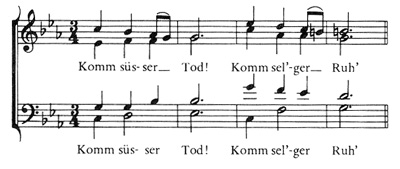
This use of the tetrachord had seen a long history before the time of Bach. The beginning of Dowland's Lachrimae (Flow My Tears) employs the same succession of tetrachords in its melody. The following two-voice elaboration of the tetrachord occurs twice in an anonymous fifteenth-century song.9 (Ex. 7)
Ex. 7. Anonymous, "Alas Departynge Is Ground of Woo," Mellon Chansonnier

The second part of the deploration on the death of Ockeghem by Josquin des Prez calls upon the students of the dead composer by name to mourn: Acoutrez vous d'abitz de deuil (Dress yourselves for mourning) and later Et plorez grosses larmes d'oeil (And weep great tears). (Ex. 8)
Ex. 8. Josquin des Prez, Nymphes des bois, measures 111-117 and 127-133

Both texts are set to the same musical phrase in which the Phrygian tetrachord in the bass and the closing Phrygian cadence both bring death into the musical context. (One should not overlook the metrical cut of the first three measures, an early appearance of a familiar dactylic death rhythm.)
In his Holy Week motet, whose text is a double lamentation, first over the destruction of Jerusalem and second over its rejection of the Messiah, Victoria begins with the tetrachord in the top voice. It subsequently recurs no less than eleven times in all four voices during the course of the motet, along with other figures of the Phrygian Inflection not yet discussed. (Ex. 9) It is a highly concentrated "Phrygian" work, though not in the Phrygian mode.
Ex. 9. Tomás Luis de Victoria, "O vos omnes"

Mozart's works, like those of Bach, Schubert and Mahler, are an inexhaustible source of examples of the Phrygian Inflection. The following two will serve as evidence of the association of the tetrachord with death. In the overture to Don Giovanni, the ineluctable adversary death is announced over the descending tetrachord in the bass. (Ex. 10)
Ex. 10. Mozart, Overture to Don Giovanni, measures 5-10

The opening pages of his Masonic Funeral Music have several recognizable death gestures among which the tetrachord is predominant. (Ex. 11) The descending spirals in the bass and in the violins of measure 8 will be referred to below.
Ex. 11. Mozart, Maurerische Trauermusik, K. 477, measures 1-9

One Schubert example stands for hundreds—the closing measures of Erlkönig with their stark disclosure of death. (Ex. 12) The key relationship (A-flat major-G minor) and the Neapolitan sixth that prepare the tetrachord will be discussed below.
Ex. 12. Schubert, Der Erlkönig
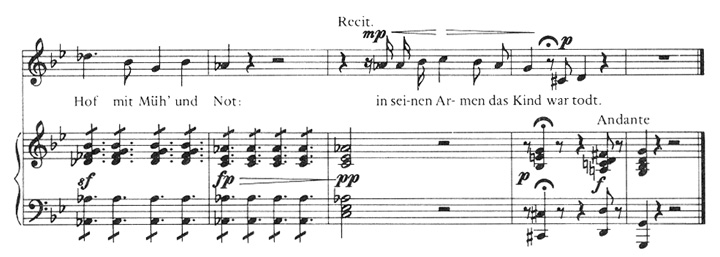
In the "Crucifixus" of Beethoven's Missa Solemnis the entombment is through the same Phrygian tetrachord. (Ex. 13)
Ex. 13. Beethoven, Missa Solemnis, "Credo" (et sepultus est)
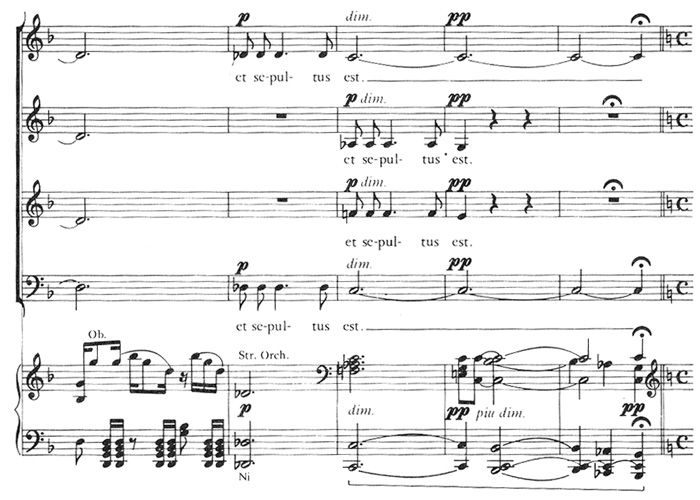
In the last song of the Schumann cycle Frauenliebe und Leben, death, who has just taken the woman's husband, appears in an unforgettable double statement of the following four-measure phrase, dominated by the gapped form of the tetrachord in the bass. (Ex. 14)
Ex. 14. Schumann, Frauenliebe und Leben, Opus 42, "Nun hast du mir den ersten Schmerz getan"

Example 15 will be recognized as the Death-summons motive from Die Walküre, accompanying Brünhhilde's appearance to Siegmund. Two gapped tetrachords in the bass govern the motive.
Ex. 15. Wagner, Die Walküre, Act II, scene 4, measures 9-12
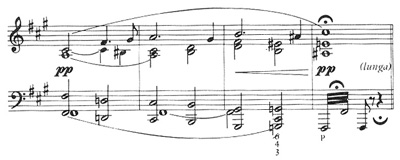
Hugo Wolf's Zur Ruh, zur Ruh inclines toward death through two overlapping tetrachords, one in the piano and the other in the voice. (Ex. 16)
Ex. 16. Hugo Wolf, Zur Ruh, zur Ruh, measures 1-4

The final example of this group, from the very end of the tonal era, is of the tetrachord as an inner voice in a three-fold ostinato repetition of the male chorus in Schoenberg's Gurre-Lieder. (Ex. 17) The tetrachord lies in the first bass part and is set to the text, "And we are the sorrows and the pains of death."
Ex. 17. Schoenberg, Gurre-Lieder, Part III, Cue number 69
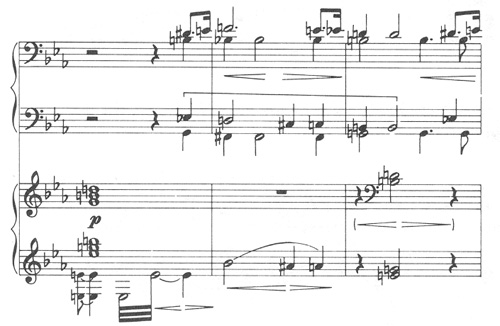
Copyright 1920 by Universal Edition. Copyright renewed. Used by permission of European American Music Distributors Corp., Clifton, New Jersey (for international rights) and Belmont Music Publishers, Los Angeles, California (for U.S. and Mexico rights).
In the examples noted above the simple tetrachord in one of its forms is the crucial melodic-thematic or bass gesture. Just as frequent is its appearance as the substructure of a more ornamental melody—a figured version of the tetrachord—as exemplified in the following three examples. The sixth movement of Brahms' Requiem (Ex. 18) begins with the thematic idea to the text "Here on earth we have no enduring place."
Ex. 18. Brahms, Ein deutsches Requiem, Opus 45, sixth movement, measures 3-7

Mahler's song cycle Kindertotenlieder (Songs on the Death of Infants) opens with a poignant oboe melos. (Ex. 19)
Ex. 19. Mahler, Kindertotenlieder, measures 1-5

From Edition Eulenberg 1060. Used by permission of C.F. Peters Corp., sole selling agents.
Perhaps the most eminent example of music's down-going in death through a Phrygian descent is that which concludes the second part of Bach's Actus Tragicus where the pulsations of the instruments gradually cease, one by one, leaving the soprano voice, enveloped in silence, to succumb in a figured version of the tetrachord. (Ex. 20)
Ex. 20. J.S. Bach, Cantata BWV 106, Part 2, measures 182-185
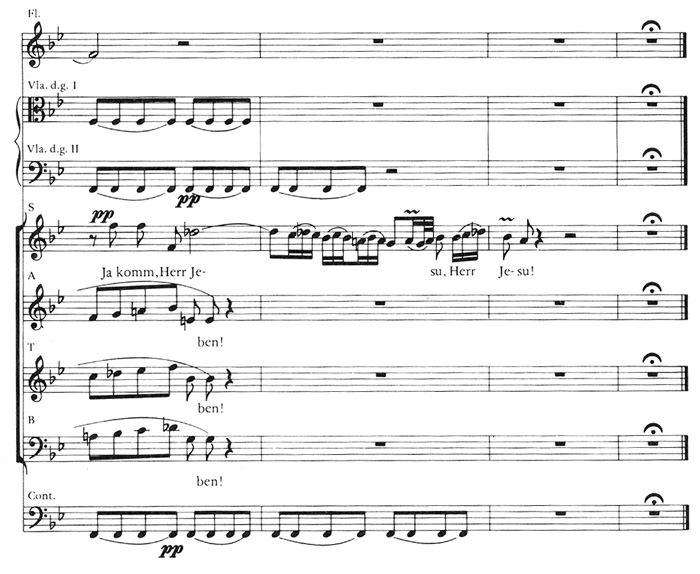
The melodic descent of death-oriented gestures is not always confined to the tetrachord. Longer and shorter melodic descents that terminate in the half-step carry with them the Phrygian quality. One may then by extension speak of descending melodic gestures also as Phrygian octaves, sevenths, sixths, fifths, or thirds. Two examples will serve. The first, from Schubert's Die Krähe, of an octave descent which by means of a lowered second degree encompasses the Phrygian octave. (Ex. 21)
Ex. 21. Schubert, Winterreise, "Die Krähe," measures 1-5
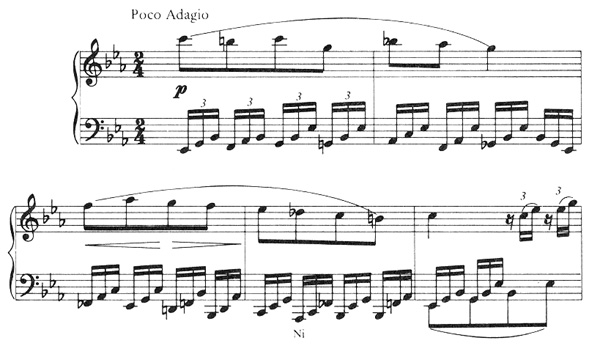
The second and incomparable example, from the final chorus of the Passion According to St. Matthew, is the long melodic descent encompassing a ninth during the course of which the intensity of anguish with which it begins at the peak of a dominant ninth chord is gradually transformed into the quiet resignation with which it terminates. (Ex. 22)
Ex. 22. J.S. Bach, Matthäuspassion, final chorus, measures 75-80
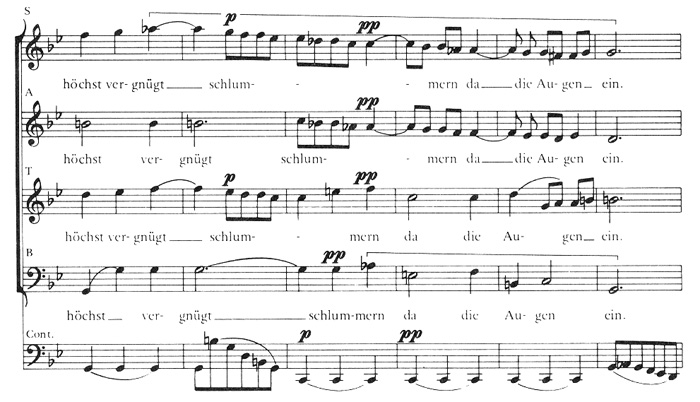
Notice also the rhythmic articulation of the melody which liberates itself from the control of the triple meter. Finally, notice the spiral descent of the vocal bass, a gesture to be discussed presently.
The crucial semitone, the crux of the Phrygian Inflection, occurs in all three modes (Phrygian, major and minor) at the following points: 4-3, 6-5, 8-7, flat 3-2, and with the Neapolitan alteration at lowered 2-1. I have maintained that wherever this semitone occurs as the terminus of a descending melodic gesture, it carries with it a quality closely akin to that of the Phrygian tetrachord. All of the above semitones might therefore for convenience be referred to as the Fa-mi inflection, as suggested in the section on derivations. That this crucial half-step alone and by itself has powerful death implications can be demonstrated by two eminent examples, the first that of Donna Anna's discovery of her father's corpse. (Ex. 23) This Fa-mi inflection haunts the entire score of Don Giovanni as an almost insidious presence.
Ex. 23. Mozart, Don Giovanni, No. 2, measures 1-5

The second famous example is the Fate motive of Wagner's Ring, a Phrygian cadence built upon a powerful Fa-mi bass. (Ex. 24) Its death implications are fortified by its appearance as the cadence of the Death-summons motive of Example 15 above.
Ex. 24. Wagner, Der Ring des Nibelungen, Fate motive

It may be recalled that the final tragic gesture of the voice at the conclusion of Schubert's Winterreise ("Der Leiermann") is a pathetic Fa-mi inflection (here lowered 6-5) and that the successive outcries of the Son in Erlkönig as well as the initial vocal gesture of the song are also Fa-mi's.
The discussion thus far has considered the Phrygian melodic descent from larger to smaller spans—octave to tetrachord to the smallest Fa-mi terminus inflection. The descent gains in intensity as it approaches the terminal crux. One is thus led to question this terminal note itself, the role played by the mediant note of a major key, that of the note e in the tonal system, and by analogy the note b of the upper Phrygian tetrachord. The following observations are admittedly speculative, since far more careful investigation is needed to make a strong case here for a thanatology of music.
The ambiguity and instability of the third scale degree is well known both from tuning theory and from musical practice. Its facility as a pivotal tone in oscillations between the major and related minor keys suggests that this point in a key possesses a "vulnerability," that is it represents an unclear dividing line between the two reciprocal regions of the tonal system and hence in terms of this article between regions of relative light and shadow, of the relative dominance of the powers of life and death. It is in the works of Schubert and Mahler, composers much of whose music is recognized as being death haunted, that this tonal ambiguity is most prevalent. It is too familiar to require examples here. However, the ambivalence of the tone mi requires further examination. It is apparent in the contrasting qualities it possesses, as the terminus of the central Phrygian tetrachord in the scale on the one hand and as the chord third of the major tonic triad on the other.
Every serious discussion of death includes a discussion of what may be called the love-death syndrome—the intimate, almost symbiotic relationship between two powers; the roles of the tone mi in the tonal system seem to confirm it.10 Its special and peculiar intensity and incandescence as a major third has been recognized and continuously exploited melodically as initial, climax, or final tones in contexts of ecstatic erotic love or mystical longing or aspiration. Example 25, a locus classicus, will be recognized as the ever-recurring melodic gesture of ecstatic love in Mozart's operas—the ascent through a major sixth to the mediant tone followed by a diatonic descent.
Ex. 25. Mozart, Die Zauberflöte, No. 3, "Dies Bildnis ist bezaubernd schön"

Note that the terminal notes of the two phrases produce a Fa-mi inflection, and that the whole articulates the Phrygian scale. This same rise through a sixth to a climactic third is everywhere prominent in the works of Richard Strauss, a gesture which carries the eloquent rhetoric of his most ecstatic passages, as in Don Juan. (Ex. 26)
Ex. 26. Richard Strauss, Don Juan, measures 91-94

© 1904 by Jos. Aibl. Renewed 1932 by C.F. Peters. Used by permission.
In the closing measures of Tod und Verklärung, the same aspiring gesture, heightened by the upward octave displacement of the e, liberates itself through three successive cadential harmonizations. (Ex. 27)
Ex. 27. Richard Strauss, Tod und Verklärung, final measures

© 1904 by Jos. Aibl. Renewed 1931 by C.F. Peters. Used by permission.
In the first cadence, it is pulled back into the aura of death sounding through the Phrygian implications of the chord of the lowered sixth. This gravitational pull is relaxed in the second cadence to the chord of the submediant, and then disappears entirely in the final melodic resolution into the equilibrium of the transparent C major chord. The final pages of this work are dominated by the tone e which continues to illuminate the last chord as the outermost exposed third in the piccolo.
The Romeo of Berlioz' Romeo and Juliet voices his longing through the same melodic gesture, the principal theme of the second movement, here returning to the mi (e) in a prophetic Fa-mi inflection. (Ex. 28)
Ex. 28. Berlioz, Roméo et Juliette, second movement, "Larghetto expressivo"

The passion of the most eminent lovers in nineteenth-century opera characteristically springs from the intensity of an initial melodic mi: Walther, Don José, Faust, Senta, Louise. The "Prize Song" in C major not only begins on e but also descends through the Phrygian tetrachord to the lower octave e before its ecstatic rise to the dominant. The ambivalent qualities of the mediant note are peculiarly present throughout this aria.
At the opposite pole of the spectrum one notices the frequency with which the mediant appears as the final, inconclusive melodic tone in works whose dramatic or poetic substance implies a passing over or out into a "beyond." The following works are but a few of the many whose final tonic chord retains the chord third as its upper, exposed tone. The "Crucifixus" of the Mass in B Minor; the requiems of Berlioz, Verdi, Fauré and Britten; Strauss' Lieder Allerseelen, Heimkehr, Im Abendrot (his Death and Transfiguration has been noted above); Mahler's Kindertotenlieder with "morendo" specified and his ninth symphony with "sterbend" specified. Vaughan Williams' Symphony in E Minor dissolves with an extraordinary oscillation between second inversion E-flat major and E minor triads, the chord third (g) as the recurring pivotal tone. The last melodic gesture of Tristan und Isolde rises to the chord third. In Example 20 above the last tone of the "expiring" soprano in the Bach cantata is the mediant.
Now the same tone mi, as the goal of a rising melodic gesture and as the terminus of a falling Phrygian gesture, as the sound of impassioned intensity and as the last fading sound of a dying movement, articulates in music the two extremities of human experience—ecstatic erotic or mystical love and the encounter with death, two points beyond which beings pass over into what Heidegger calls the hiddenness or concealment of being. To paraphrase Rilke, ecstasy "is the beginning of a terror we are just able to bear." At the risk of appearing fantastical, and to speak in metaphor, I would suggest that this precarious and ambivalent tone conceals behind it an opening into a musical void; that musical energies are driven violently toward it, circle hypnotically around it, or are drawn irresistably toward it as by the vortex of a whirlpool.11 Note the role of mi in Example 29 from the quasi-funeral march of Brahms' fourth symphony.
Ex. 29. Brahms, Symphony No. 4 in E Minor, Opus 98, second movement, measures 1-4

Two final cases must be cited where the single tone e (or by analogy b) has the power to articulate the uttermost of ecstasy or of terror. The first is the long orchestral crescendo on the unison e, gradually reinforced through multiple octave doublings, in the last song of Mahler's Lied von der Erde, just preceding the climactic apotheosis of the earth and before the music's final dissolution (cue 57-58). The parallel case on the analogous note b of the musical system is the horrendous pair of orchestral unison crescendos immediately following the murder of Marie in Berg's Wozzeck (Act III, cue 110).
Again I would emphasize the tentative, suggestive, and speculative character of the above reflections upon the significance of the mediant tone and of the note e in the tonal system. Its special kind of intensity seems unmistakable and appears to have been recognized as peculiarly appropriate by a variety of composers for "peak experiences" or for being-in-extremis. The entire question demands a more thoroughgoing analysis than is possible here.12
In concluding the section on melodic gestures, there remains one other important configuration which must be classed as a death gesture—the Descending Spiral. (Ex. 30)
Ex. 30. The Descending Spiral

It is not unrelated to the Phrygian tetrachord, for in its most common form, the spiral of fourths, it provides the most common counterpoint, especially as a bass, to the descending Phrygian tetrachord and scale. One recognizes in the first four notes the first phrase of the Romanesca bass.13 This spiral occurs in both its diatonic and chromatic forms. It transforms the linear harmonic descent by thirds into a spiral descent.
From earliest times the spiral gestalt has appeared along with the labyrinth as a symbol of transformation—of the life and death cycle: generation-growth-decay-death-rebirth or regeneration.14 The ascending clockwise spiral is associated with creative power, growth, and life; the descending counterclockwise spiral with decay, destruction, and death. The combination of the two, the double spiral, symbolizes the perpetual transformations from life to death and from death to life.

This shape appears also in the musical turn figure  and there are numerous examples where a composer employed it with this transitional or transformational implication. In Baroque Figurenlehre this figure, called kyklosis, was recommended for texts implying a turning or returning or changing of course. A dramatic example is the theme of Countess Almaviva's "Dove sono" in which she reflects upon the course of her love from its first flourishing to its present demise in an aria which issues in hope for its regeneration and return. The principal melodic gesture of the aria is a slow turn or double spiral. Note also its prominent role in Example 43 from Mahler's ninth symphony. It is the initial vocal gesture of Schubert's Erlkönig and a prominent feature of Isolde's "Liebestod" (Ex. 31) where it amplifies the ecstatic rising sixth in a sequence of phrases whose terminal notes descend through a chromatic Phrygian fifth to terminate in the root of a momentary E major tonic. One cannot, of course, interpret every occurrence of an ornamental turn in this manner.
and there are numerous examples where a composer employed it with this transitional or transformational implication. In Baroque Figurenlehre this figure, called kyklosis, was recommended for texts implying a turning or returning or changing of course. A dramatic example is the theme of Countess Almaviva's "Dove sono" in which she reflects upon the course of her love from its first flourishing to its present demise in an aria which issues in hope for its regeneration and return. The principal melodic gesture of the aria is a slow turn or double spiral. Note also its prominent role in Example 43 from Mahler's ninth symphony. It is the initial vocal gesture of Schubert's Erlkönig and a prominent feature of Isolde's "Liebestod" (Ex. 31) where it amplifies the ecstatic rising sixth in a sequence of phrases whose terminal notes descend through a chromatic Phrygian fifth to terminate in the root of a momentary E major tonic. One cannot, of course, interpret every occurrence of an ornamental turn in this manner.
Ex. 31. Wagner, Tristan und Isolde, "Liebestod," measures 34-37
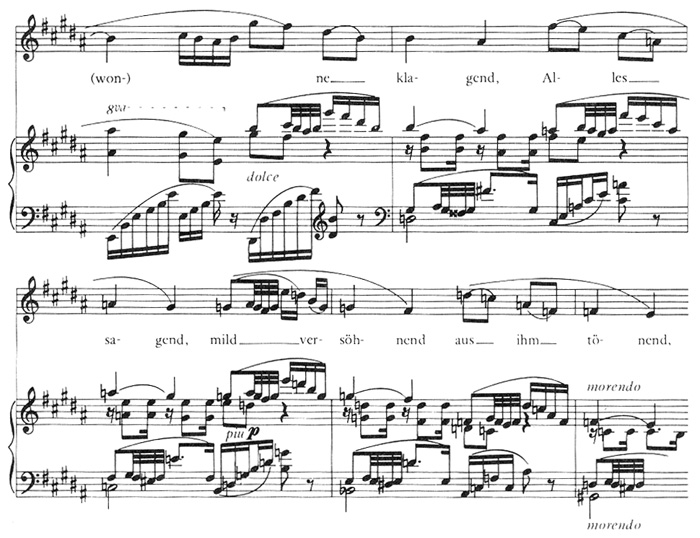
A very early (twelfth century) example of the descending spiral's association with death is that of the lamentation of Rachel on the slaughter of the firstborn, transcribed by Théodore Gérold for his study of music in the Middle Ages.15 (Ex. 32)
Ex. 32. Massacre des Innocents, MS. Saint-Benoit-sur-Loire

The text reads, "How shall I rejoice while I look at dead limbs . . . . In truth the boys have caused me to grieve without end." A common gesture in Bach, the following example (Ex. 33) of the spiral from the ritornello preceding the aria text "I stand with one foot in the grave" is typical.
Ex. 33. J.S. Bach, Cantata BWV 156, second movement, measures 9-12
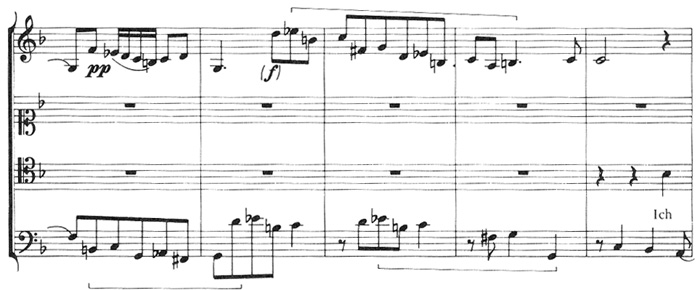
The first three measures of this same ritornello are dominated by a melodic descending Phrygian sixth in the bass. See also the last example of this article.
A most striking example articulates the destruction of the hero in Beethoven's Coriolan Overture. (Ex. 34)
Ex. 34. Beethoven, Coriolan Overture, measures 284-296

One should recognize this as the inverse of the rising spiral of power that constitutes the principal theme of the overture, (Ex. 35) whose momentum is countered and checked by the descending Phrygian tetrachord and augmented sixth chord in the bass.
Ex. 35. Beethoven, Coriolan Overture, measures 15-20
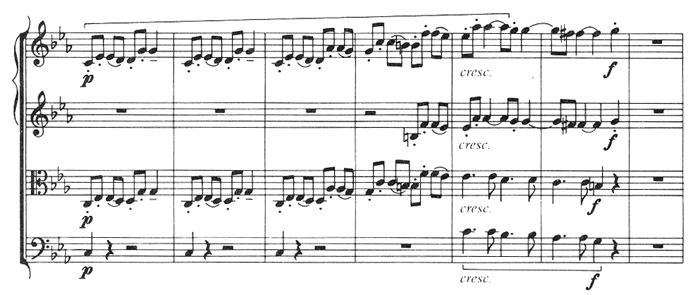
The same spiral is included by Mozart twice in the first measures of the Masonic Funeral Music. (Ex. 11 above) A more forceful example is that which articulates Donna Anna's obsessive preoccupation with the death of her father and its vengeance. (Ex. 36)
Ex. 36. Mozart, Don Giovanni, Act I, "Or sai, chi l'onore," measures 25-29
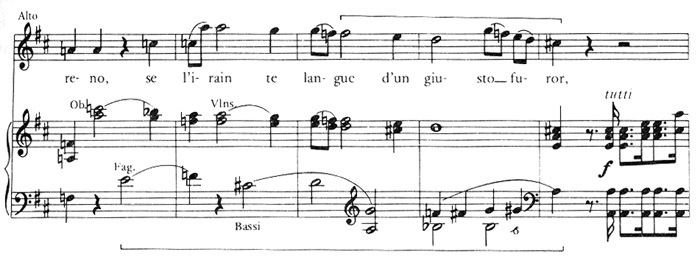
One can construe this bass also as a chain of subsumptio's, the Baroque rhetorical figure first identified by Christoph Bernhard in the middle of the seventeenth century: the insertion of a lower neighbor in descending leaps.16 Bernhard's example accompanies the text "vedete me morire" (observe my dying) and because of its continued use during the following three centuries in contexts which explicitly refer to death, this figure must be included among the musical death-bearers.
There are other, non-quartal descending spirals that often occur in contexts of death, spirals of descending thirds, fifths, sixths, and even octaves, or of mixed intervals. A four-voice cascade of spiral thirds in overlapping points of imitation voice the lamentation that concludes Josquin's deploration on the death of Ockeghem. Note the opening spiral of thirds in Example 32 above. Note also the spiral of octaves that opens the overture to Don Giovanni (Ex. 10 above) and the awesome expanding spiral in the final exchange between Don Giovanni and the Commendatore that sounds the death of the hero. (Ex. 37)
Ex. 37. Mozart, Don Giovanni, Act II finale, measures 537-555
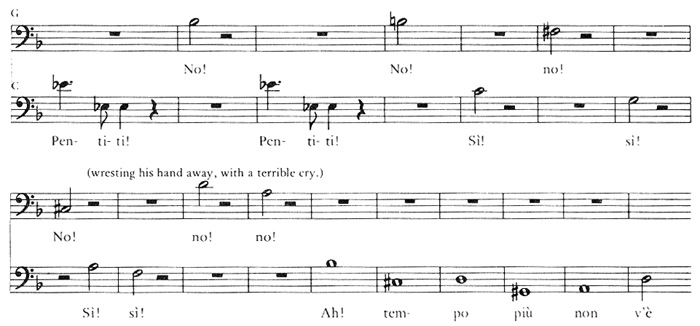
Numerous similar examples of this use of the descending spiral could easily be included, and some will be considered in the section on Structural Configurations. If its association with death is thus established, one is forced to rethink its implications in other "abstract" works such as Mozart's "little" Symphony in G Minor, K. 183, Haydn's "Quinten" Quartet, Opus 76, no. 2, the Adagio of Beethoven's Symphony in D Minor, the "Hammerklavier" Sonata, and the opening measures of Mahler's first symphony, especially here with its articulation of the Phrygian octave. Then there is the theme of Bach's Passacaglia in C Minor whose initial rise is deflected by a forceful Fa-mi and returns through the descending spiral to the tonic. The same spiral is crucial in the first measures of the Toccata in D Minor BWV 565.
C. HARMONIC CONFIGURATIONS
Needless to say, the melodic gestures described above are at the same time bearers of harmonic implications. A few of the most significant of these will be isolated in this section. Harmonization of the descending Phrygian pattern gave rise to a variety of cadence types belonging to the "vocabulary" of the Phrygian Inflection. The earliest were the model cadences in both natural and altered forms. Subsequent elaborations of this cadence formula as a death symbol were given by Arnold Schering in his studies on musical symbolism.17 (Ex. 38)
Ex. 38. Phrygian cadences
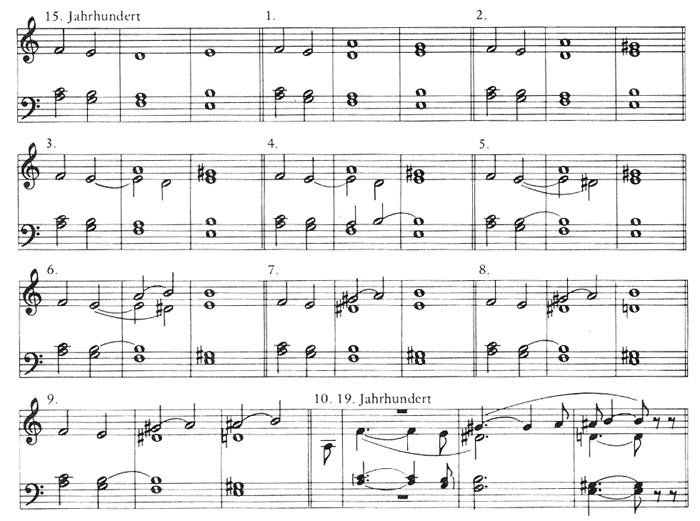
By the eighteenth century the most dramatic of these death-announcing gestures were those cadences employing the augmented sixth chords and the Neapolitan sixth on the penultimate melodic notes.18 One example from Mozart will serve as illustration. (Ex. 39)
Ex. 39. Mozart, Le Nozze di Figaro, No. 19, measures 23-26

It occurs at the critical turning point in The Marriage of Figaro where the Countess faces the crisis of her own necessary downgoing in humiliation (symbolic death). The bass articulates the full tetrachord. Simply the cadence by itself without the accompanying melodic descent served the same purpose, as two lamentations unto death will demonstrate: that of Pamina (Ex. 40a) and that of Constanza. (Ex. 40b)
Ex. 40a. Mozart, Die Zauberflöte, No. 17, measures 5-7
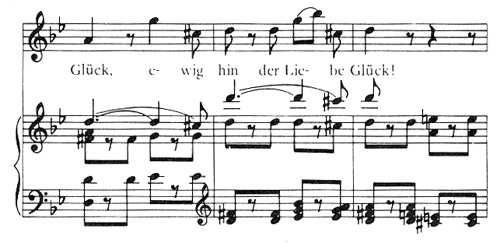
Ex. 40b. Mozart, Die Entführung aus dem Serail, No. 10, measures 1-4
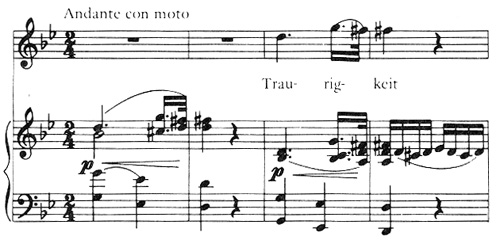
That the Phrygian cadence had more than merely musical-syntactical implications is demonstrated by the second movement of Bach's Brandenburg Concerto No. 3 whose Adagio consists solely of a Phrygian cadence. If the case being made for the death implications of the Phrygian Inflection is valid, then the great body of Baroque middle slow movements, which almost invariably close with a Phrygian cadence that is not a half cadence to the key of the following movement, are "meditations on death" between two life-affirming allegros. Bach considered the cadence by itself sufficient to communicate to its hearers the customary substance of a medial Adagio, as Wagner knew that the same cadence, his Fate motive, was fully adequate to embody its fatalistic implications. (Ex. 24 above)
It must be noted in passing that while the augmented sixth form of the cadence throughout the eighteenth and nineteenth centuries became the most common, almost inevitable harmonic death gesture, it was also, especially during the period of Neapolitan opera, the appropriate formula for all questions, especially in recitative.19 Gradually Mozart dropped the convention, retaining it primarily for dramatic and rhetorical questions. One is forced to ask why the same formula that served as a musical question mark for even the most casual questions became at the same time the musical gesture for the most profound, tragic and mysterious of human problems—that of suffering, lamentation and death. One answer could be that because death is the ultimate and insurmountable question posed by life, all penultimate questions carry with them in varying degrees something of the problematical quality of this ultimately unanswerable mystery.
Like the cadences discussed above, those incorporating the Neapolitan sixth chord also occur prominently in contexts of death, from Carissimi to Schoenberg. Due to its proximity to the tonic in the lower of the two Phrygian tetrachords its quality is heavier and duller, and it speaks with greater finality. It has already appeared in preceding examples (Nos. 12 and 21) and will recur below in Example 45. One explicit example from Bach will serve here, a remarkable recitative in which musical structures are continually corrupted. (Ex. 41)
Ex. 41. J.S. Bach, Cantata BWV 26, No. 3, measures 8-10
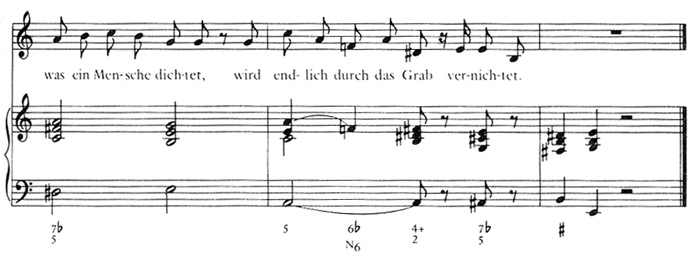
The text declares that all earthly goods—joy, beauty, power, fame, honor, the sciences and the arts—"become ultimately, through the grave, annihilated." The entire recitative and the cadence itself deserve far more attention than is possible here. Note also the final descending spiral of the melody.
Not only in cadences, but in many non-cadential progressions, the Neapolitan chord carries death-oriented connotations, as in the first two measures of the soprano lament aria of Bach's Cantata No. 21 (Ex. 42a) and at the climax of Schubert's Die böse Farbe to the impassioned outcry, "Would that my tears might bleach all the green grass deathly pale." (Ex. 42b) Note also the tetrachord implications of the bass in the Bach example.
Ex. 42a. J.S. Bach, Cantata BWV 21, "Seufzer, Tränen, Kummer, Not," measures 8-10
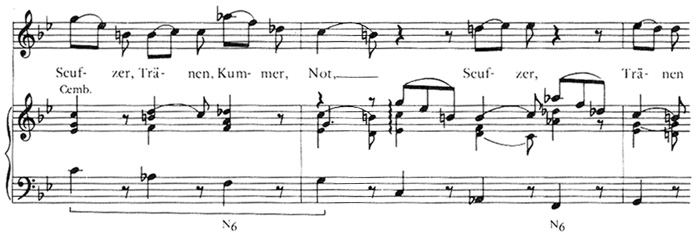
Ex. 42b. Schubert, Die schöne Müllerin, Opus 25, No. 17, "Die böse Farbe," measures 19-22
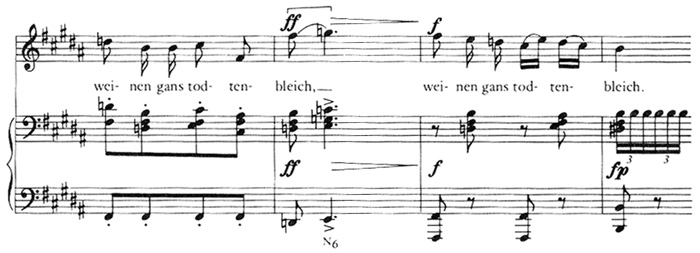
From the above examples one recognizes that the chords on the lowered sixth and second scale degrees are the critical harmonic carriers of the Phrygian Inflection and of its implications for death. The former, with its gravitation toward the dominant, is the most dramatically intense; the latter, with its tonic orientation, is more grave, heavy and ineluctable. The prominence of the Fa-mi inflection in these cadences leads finally to a consideration of the plagal cadence, whose special pathos springs from the presence of this Fa-mi inflection in its voice leading as the positive character of the perfect cadence springs from the reciprocal counter-inflection ti-do—two different types of finality. Their implications for a musical thanatology remain to be investigated. Let us note here merely that the sense of termination or finality in tonal music has been accomplished most often by a movement toward the subdominant pole, and also that in many movements of the Bach cantatas where the text is about death the first harmonic progression is from tonic to subdominant.
The discussion of harmonic configurations must conclude with a reference back to the descending spiral among melodic gestures. Obviously this spiral, when used as a melodic bass line, generates a variety of harmonizations, from that of the strong Romanesca to the striking variants that form the thematic substance of the last movement of Mahler's ninth symphony, generally recognized as a farewell and death-oriented work. (Ex. 43)
Ex. 43. Mahler, Symphony No. 9, fourth movement, Adagio, measures 1-4 and 7-8
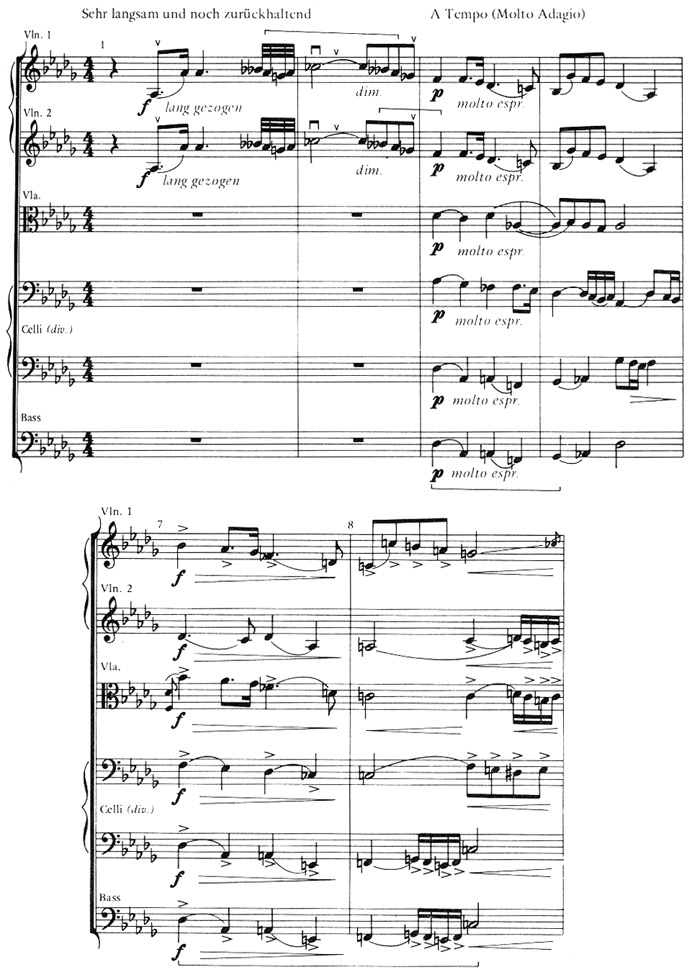
Copyright 1912 by Universal Edition. Copyright renewed. Used by permission of European American Music Distributors Corp., Clifton, New Jersey.
Note not only the harmony-generating spiral bass of this principal and dominant theme of the movement, but also the following additional death-related features: the Phrygian implications of the melodic descent in measure 2 from the implied d-flat of the tonic through the a-flat, and from the b-double flat to f; the prominence of mi as the initial melodic note and of the chord thirds in measure 3; and the eloquent melodic double spiral or turn which permeates the entire fabric of the movement. One familiar with the symphony will recognize in this opening harmonization of the descending bass spiral a profoundly calm and resigned version of the grotesque and almost savagely disruptive harmonizations of the same spiral that form the substance of the Trios of the second movement.
D. STRUCTURAL CONFIGURATIONS
The following discussion on the appearance of death in larger structural and formal units will be brief and suggestive only. If what has been said above is at all convincing, it follows that what has been called the Phrygian Inflection must operate similarly in larger structural and formal units.
The descending tetrachord as a harmonic bass has already appeared in some of the examples, both singly as the harmonic shape of a phrase, and multiply as a recurring, governing ostinato design. If it can organize a phrase, it can also organize a period or even a larger formal segment. (A sonata movement whose second key area is that of the lowered sixth might be said to articulate the gapped form of the tetrachord which is completed by the dominant preparation for the recapitulation.) A dramatic example is that of Don Giovanni's first encounter with the statue in the graveyard (no. 22 in the opera). At the moment the Don addresses the statue the tonal center drops abruptly from E major to C major and then to B. The same progression is repeated immediately after the statue's "Si!" (measures 59- 91). (Recalling what was said above with respect to the single tone e of the musical system, note that the statue's ominous, monosyllabic answer is the single whole note e.)
The concluding fifty measures of the Berlioz Requiem from "Et lux perpetua" are constructed on an extended three-fold tetrachord structure, the first two descending from G to D, the last from C to G with the Neapolitan inflection. Through an unusual series of cadences from the triads of each tone of the tetrachord, the Phrygian character of final descent is intensified. Thus: IV-I, iii-I, flat II-I, flat II-I, V-I.
Though not everyone is sympathetic to Alfred Lorenz's harmonic analyses of Wagner's operas, it is worth noting here that he considers Tristan to be one long, elaborately worked out Phrygian cadence from the opening A minor (iv) to the concluding B major (V) in a work whose implicit tonic (I) is E major.20 This is not the place to argue the merits of his demonstrations.
Similarly the Neapolitan inflection can serve as the tonal basis for the formal organization of larger sections. A telling case is that of Example 12 above, where at the close of Erlkönig preceding the final G minor cadence, Schubert shifts from G minor to A-flat major. The same Neapolitan relationship constitutes the key structure of the Erlking's final threat (measures 116-123), there D minor and E-flat. Perhaps a more melodramatic example is that of the E-flat major eruption of the "Tuba mirum" of Berlioz' Requiem out of the D minor of the preceding section.
As in the sections on melodic and harmonic configurations, where the analysis led from consideration of the tetrachord to the Fa-mi relationship and from there to the terminal note mi, logical consistency would call for a consideration here of the structural functions of the mediant chord and of the mediant key. However, this cannot be undertaken here.
Finally one must question the E modes and their rapport with death. I do not intend to enter the highly problematic area of key qualities. Evidence of the appropriateness of the Phrygian mode for situations of death is too wide-spread in sixteenth- and seventeenth-century theory and practice to warrant repetition here. One might further maintain that a composer who is sensitive to the tonal system as a whole and to its development from the archetypal scales mentioned at the beginning of this article, origins still preserved in the notational system, such a composer might, in spite of the radical relativization of keys, still preserve an intuitive sense of the special character of the tone e (and correspondingly of the b of the upper Phrygian tetrachord). Here I will mention only a few well-known cases: the E minor of the opening chorus of the Passion According to St. Matthew; the "Crucifixus" of the Mass in B Minor; the quasi-funeral march of Brahms' Symphony in E Minor; the E major of the graveyard duo of Don Giovanni; the E major "Rex Tremendae" of Berlioz' Requiem; the special role of B minor in the music of Bach and Schubert as a whole; and the B minor of Tchaikovsky's "Pathétique" Symphony.21
There remains for consideration only the role of the descending as a structural device. The descending spiral of fifths—C-F-G-C—defines tonality as a whole. As a chord progression or cadential formula it carries the strongest inevitable motion toward finality. As the substructure for longer formal units it preserves this same character.
The descending spiral of fourths has already appeared in examples as a harmonic bass or melodic line defining the structure of phrases (Ex. 33 and 34). What is perhaps the most eloquent down-going in willing acceptance of death in all orchestra literature is the concluding orchestral ritornello to Pamina's lament aria in The Magic Flute. (Ex. 44)
Ex. 44. Mozart, Die Zauberflöte, No. 17, measures 38-41

Not only is there a two-octave spiral descent in the bass, but also the principal melody is simultaneously a figured version of the same spiral and one which contains as its peak tones two descending Phrygian tetrachords: g—f—e-flat—d and c—b-flat—a-flat—g, the Phrygian octave scale. Its final and consummating gesture is the Neapolitan inflection in both the melody and the harmonic cadence.
This article must conclude with a superlative example of structures of death in music from Bach's Actus Tragicus. (Ex. 45)
Ex. 45. J.S. Bach, Cantata BWV 106, second movement, measures 40-47
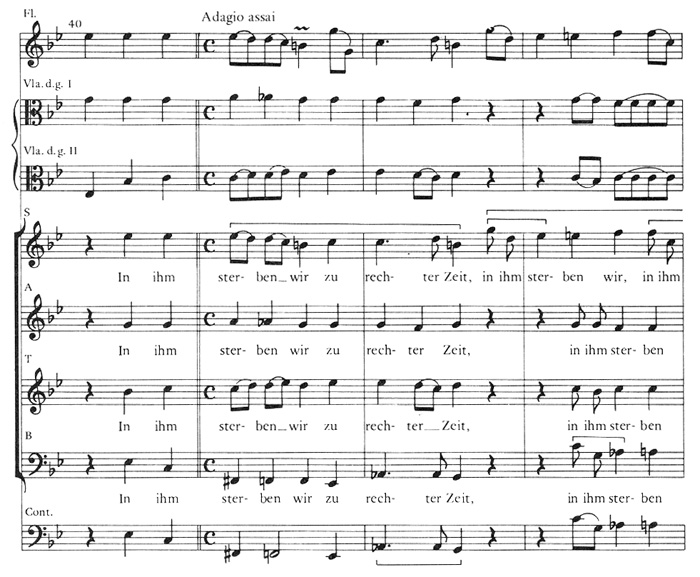
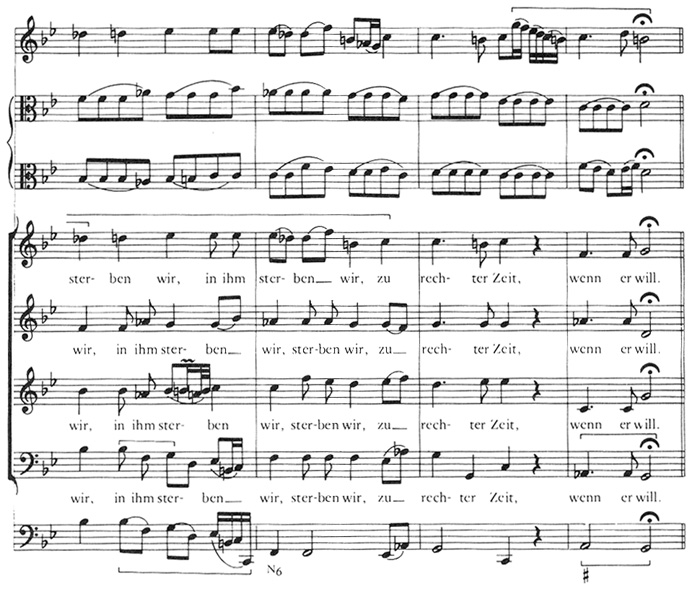
It is his embodiment of the third phrase of the text:
God's time is the best of all times.
In Him we live and move and have our being;
In Him we die at the right time—when He wills it.
Following an E-flat fugal setting of the second line, Bach compresses together in a short eight-measure period multiple gestures of the Phrygian inflection in a powerful evocation of death: the shift of key toward C minor, the diminished form of the tetrachord in the soprano, the Phrygian cadence in the second measure, the dialogue of subsumptio's between soprano and bass (third and fourth measures) which initiated the dramatic descending spiral of the bass (measure 4), the transformational turn figure worked into the tenor line (measure 4), the Neapolitan sixth (measure 5), the long figured version of the descending Phrygian fifth in the soprano from measure three to seven, the same descent in radical contraction in the flute (measures seven and eight), and the final Phrygian cadence with its prominent Fa-mi in the bass. This long, multisectioned movement of the cantata undergoes its transformation from a structure of life toward that of death, which is finally consummated in the famous soprano Phrygian descent at the end of the composite aria-with-fugue-with-chorale-cantus-firmus that concludes this part of the cantata. (See Ex. 20 above.)
E. SUMMARY AND CONCLUSION
This article began with a series of presuppositions:
(a) that authentic being can be encountered only through the acceptance and understanding of death as the ultimate possibility of man's being, as the ever present matrix or ground in the presence of which one's activities acquire their meaning, and as an active agent, perpetually present in the career of beings;
(b) that the musical work is not first of all an imitation, expression, representation, or symbolization, but is an autonomous and self-sufficient being among the beings of the world whose meaning is disclosed in the structures through which it achieves, develops, and consummates its being. The approach was therefore ontological, not psychological or linguistic;
(c) that as a being among beings, the musical work participates in "the game of being" (Heidegger) in which the powers of life and death (being and non-being) engage in continuous dialectical interplay;
(d) that the measure of the greatness of a work is the degree to which it discloses the depth of this dialectic: The power of a being is measured by the degree of non-being it is able to absorb and integrate into itself without being destroyed by it;22
(e) that a function of criticism as the illumination of the art work is to disclose the presence and working of death in the musical being.
The article then addressed itself to a limited cluster of interrelated configurations and gestures which almost universally appear in contexts of death. The term "Phrygian Inflection" was coined as a convenient family name because of the prominence in them of that which derives from the Phrygian mode and tetrachord. The configurations were presented in three groups as follows:
| A. | Melodic configurations |
| 1. | The descending Phrygian tetrachord in its various forms | |
| 2. | All other melodic descents whose terminus is the Phrygian half-step | |
| 3. | The Fa-mi inflection | |
| 4. | The single tone mi in a prominent or conspicuous position | |
| 5. | The descending spiral as well as the single subsumptio |
| B. | Harmonic configurations |
| 1. | Phrygian cadences, natural or with major third in the cadence chord. (These may or may not be construed as half-cadences to the dominant.) | |
| 2. | Cadences containing the chords of the augmented sixth | |
| 3. | Cadences entailing the Neapolitan sixth chord | |
| 4. | Plagal cadences | |
| 5. | The mediant function |
| C. | Structural configurations |
| 1. | The descending Phrygian tetrachord as harmonic bass |
| (a) | Singly as the structural bass for a phrase | ||
| (b) | Multiply as an ostinato structure | ||
| (c) | As the harmonic foundation for larger formal segments, periods, or extended sections |
| 2. | Successions of tonal centers that articulate the Fa-mi inflection: this includes keys of the lowered sixth and fifth scale steps and of the lowered first and second scale steps. | |
| 3. | The role of the mediant key | |
| 4. | The E and B modes as such | |
| 5. | The descending spiral bass as harmonic, formal structure |
These devices are not to be construed to constitute a "vocabulary" with univocal connotations. Not every isolated or passing occurrence necessarily announces some aspect of death. (Nor does death appear under a single aspect. It is as often radiant, splendid, and heroic, giving rise to joy or contentment, as it is threatening and lamentable. It is even the subject of ridicule, mockery, and laughter.) Yet whenever death is implied in a work these are among the gestures in which it is most apt to be embodied.
The following conclusion must therefore be drawn from the analyses: that if the configurations and gestures described are almost universally present in works whose text, function, or dramatic idea connect them unambiguously and explicitly with death, then their conspicuous presence in so-called purely abstract works also signals the presence and the work of death in the temporal development of their being.
A question that has not been answered is whether these configurations have acquired these associations through convention and common usage or possess them ontologically, so to speak, as characteristics inherent in the very nature of the musical system itself. That the latter is the case has been constantly intimated throughout the article.
This study was limited to an identification of the loci for the appearances of death in music. This is a necessary preliminary step for the more important consideration of the manner in which they work with other configurations in the larger context of the work as a whole. For ultimately the most fundamental differences between a Bach, a Mozart, a Beethoven, Schubert or Mahler or, as Guiomar suggests, between the styles of historical periods, lie in their understanding of the dialectics of life and death as they operate throughout the realm of being and in the careers of individual beings.
A further intention behind the study was to assist the ear in the discrimination of what it hears, for the mark of the educated ear is not only its capacity to explain theoretically the succession of events it encounters, but to grasp and understand their import. And this, in the last analysis, is the function of criticism.
1Martin Heidegger, Der Satz vom Grund in James M. Demske, Being, Man & Death: a Key to Heidegger (Lexington: The University Press of Kentucky, 1970), p. 171.
2Michel Guiomar, Principes d'une Esthétique de la Mort (Paris: Librairie José Corti, 1967), pp. 27, 28.
3On the ontological status of art works see Justus Buchler, The Main of Light, Chapter VI, "Ontological Parity and the Sense of Prevalence" (New York: Oxford University Press, 1974).
4Mikel Dufrenne, The Phenomenology of Aesthetic Experience, Chapter VI, "The Being of the Aesthetic Object" (Evanston: Northwestern University Press, 1973).
5Ernest G. McClain, The Myth of Invariance: the Origin of the Gods, Mathematics and Music from the "RG Veda" to Plato (New York: Nicholas Hays, Ltd., 1976), p. 12f.
6The diminished form occurs modally only with the insertion of a leading tone. The augmented form is actually a Lydian tetrachord and is without the crucial semitone. It is included here merely to complete the classification of tetrachord types and because, due to the presence of the tritone, it serves also in contexts of death.
I have permitted myself certain licenses in the use of terms. This article is not an attempt to trace modal influences in tonal music. The approach is in no sense theoretical and explanatory; rather it is phenomenological and descriptive. The use of the term "Phrygian" is merely a convenience for designating a group of devices in tonal and prototonal music which are closely related and which function in similar, characteristic manners. Other technical terms are labels for heard phenomena.
7An elaboration of the dynamics of melodic motion can be found in Victor Zuckerkandl, Sound and Symbol (New York: Pantheon Books, 1956), Chapters VII-X.
8The career of this lament ostinato has been elaborated by Robert Müller-Hartman in "A Musical Symbol of Death," Journal of the Warburg and Courtauld Institutes VIII (1945) 199-203, and by Ellen Rosand in "The Descending Tetrachord: an Emblem of Lament," unpublished paper delivered at the annual meeting of the American Musicological Society in Los Angeles, November, 1975.
9Included in Noah Greenberg's An English Song Book (New York: Doubleday and Company, 1961), pp. 30-31.
10That "the ultimate meaning of desire is death" has been richly elaborated by René Girard in his study of the novel, Deceit, Desire, and the Novel; Self and Other in Literary Structure, translated by Yvonne Freccero (Baltimore: The Johns Hopkins Press, 1965).
11Or, to borrow metaphors from mythology, this tone is comparable to the World Navel or axis mundi, the locus where the world and the realm of gods and powers intersect, where the energies of eternity break into time, and where the creative-destructive power of the holy is operative.
12That the mediant tone mi lies "at the boundary" between being and non-being in the tonal system could be argued in several manners from music theory. First, it is the last new tone generated from the senario 1.2.3.4.5.6 and the last overtone consonant with the fundamental. Beyond it lies the realm of dissonance. Second, in the Guidonian hexachord system retained into the sixteenth century, E is the last note and upper limit of the gamut: G A B C D E. Finally, in terms of harmonic distance from the tonic in the cycle of fifths, the mediant is the furthest removed. Beyond it lies the "corrupt" and dissonant leading tone triad: I V ii vi iii vii.
13The origins of the Romanesca bass are unknown. Because of the subsequent frequent association of this bass spiral with death, one might be led to search for the origins of this dance bass in the all-pervasive dances of death in central Europe during the late fourteenth and the fifteenth centuries.
14See J.E. Circlot, A Dictionary of Symbols (New York: Philosophical Library, 1962), pp. 290-292; Edgar Herzog, Psyche and Death (New York: G.P. Putnam's Sons), p. 93ff; Erich Newmann, The Great Mother (New York: Pantheon Books, 1954), pp. 107, 177.
15Théodore Gérold, La Musique au Moyen Age (Paris: Librairie Ancienne Honoré, 1932), p. 62.
16See "The Treatises of Christoph Bernhard" in The Music Forum, III (New York: Columbia University Press, 1973), 95.
17Arnold Schering, Das Symbol in der Musik (Leipzig, 1941), p. 132.
18Manfred Bukofzer demonstrates the derivation of the Neapolitan and augmented sixth chords from the Phrygian cadence in Music in the Baroque Era (New York: W.W. Norton, 1947), p. 384.
19See Edward Downes, "Secco Recitative in Early Classical Opera Seria (1720-80)," Journal of the American Musicological Society XIV (Spring, 1961), 50-69.
20Alfred Lorenz, Der musikalische Aufbau von Richard Wagners "Tristan und Isolde" (Tutzing: Hans Schneider, 1966), p. 179.
21Alfred Lorenz in the above cited Tristan study (pp. 173-179) contends that the key of the entire work is E major (!) but that it functions like the Platonic Idea of Love [or Death]—everywhere an informing presence and goal, but never disclosing itself in its essential purity within the realm of concrete experience.
22Paraphrase of Paul Tillich, Love, Power, and Justice (New York: Oxford University Press, 1954), p. 40.


